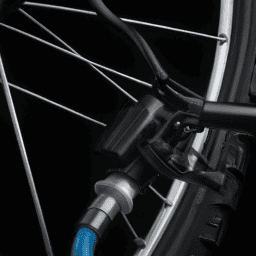As someone who loves cycling, I’ve always been intrigued by the scientific principles that allow a bike to remain balanced. What exactly enables this two-wheeled vehicle to keep upright, even when I’m neither pedaling nor turning the handlebars?
The answer to this question lies in a combination of factors, including the role of gravity and inertia, the shape of the wheels, and the rider’s body position.
First and foremost, it is important to understand the role of gravity and inertia in keeping a bicycle upright. Gravity, the force that pulls objects towards the center of the Earth, plays a crucial role in keeping the bicycle and rider from falling over. Meanwhile, inertia, the tendency of an object to resist changes in motion, helps to keep the bicycle moving forward in a straight line. Together, these forces work in harmony to keep the bicycle balanced and stable.
However, this is just the beginning of the story – there are many other factors at play that help to keep a bicycle upright, which we will explore in more detail throughout this article.
Key Takeaways
- The combination of gravity and inertia keeps a bicycle balanced and stable.
- Rider position is crucial for maintaining balance and controlling the bike.
- External factors such as terrain, weather, and bike condition can impact stability, and wind resistance affects bike stability.
- Advancements in cycling, including materials, designs, and features, as well as the incorporation of technology and electric propulsion, are transforming the industry and promoting sustainability and health.
The Role of Gravity and Inertia
You’re probably wondering how a bicycle stays upright, and it’s all thanks to the perfect balance between gravity pulling you down and inertia keeping you moving forward.
As you pedal, the force you exert on the pedals propels the bicycle forward while gravity simultaneously pulls you and the bike down.
This interplay between gravity and inertia creates a delicate balance that allows the bicycle to remain upright and in motion.
The physics of bicycling is fascinating, and understanding how gravity and inertia work together to keep the bicycle upright is crucial. Without this balance, the bicycle would easily topple over and become unstable.
However, the combination of gravity and inertia creates a stable environment that allows you to ride your bike with ease.
Now, let’s move onto the next section and explore how the shape of the wheels contributes to the bicycle’s stability.
The Shape of the Wheels
The rounded shape of the wheels plays a crucial role in maintaining balance while riding a bike. The shape of the wheels provides aerodynamic benefits, reducing drag and allowing the bike to move forward with less effort. Additionally, the shape of the wheels affects the way the bike handles and responds to different terrain. A larger wheel provides a smoother ride over rough surfaces, while a smaller wheel provides quicker acceleration and better maneuverability.
Manufacturing techniques have evolved over time, allowing for more precise and consistent wheel shapes. Modern wheels are typically made using a combination of materials like aluminum, carbon fiber, and plastic. The manufacturing process involves shaping the materials into the desired shape, making sure that the wheel is perfectly round and centered. This precision ensures that the bike remains stable at high speeds, making it easier for the rider to control the bike.
The shape of the wheels is just one factor that contributes to a bike’s stability. The rider’s body position also plays a crucial role in maintaining balance and controlling the bike.
The Rider’s Body Position
As I pedal down the road, my body becomes a sail, catching the wind and guiding the bike’s path. But how does my body position affect the bike’s stability? Balance techniques, aerodynamics, and stability all play a role in keeping the bike upright.
Firstly, maintaining a centered body position over the bike’s center of gravity is crucial for balance. This means keeping my weight evenly distributed between both wheels, with a slight forward lean towards the handlebars.
Secondly, aerodynamics come into play as I increase speed. By lowering my body into a more streamlined position, I reduce wind resistance and improve stability.
Lastly, the bike’s stability can be improved by shifting my weight to the side opposite of a potential fall, effectively counteracting the force and preventing a loss of balance.
As important as the rider’s body position is for maintaining balance, there are also external factors that can impact stability. These factors include terrain, weather, and the condition of the bike itself.
External Factors
When you hit a patch of gravel or encounter a sudden gust of wind, it can feel like your bike is being ripped out from under you. However, there are external factors that help keep your bicycle upright.
One of these factors is road conditions. Smooth roads without potholes or debris make it easier for the bicycle to maintain stability. On the other hand, rough or bumpy roads can cause the wheels to wobble and the rider to lose control. Additionally, the slope of the road can affect the balance of the bicycle. Going downhill can increase the speed and make it harder to control the bike, while going uphill can slow down the bike and make it easier to balance.
Wind resistance is another external factor that affects the stability of a bicycle. When riding against the wind, the rider must exert more effort to maintain balance and speed. Crosswinds can also cause the bike to sway and make it harder to stay upright. However, the shape and design of the bicycle can help reduce wind resistance and improve stability. For example, aero handlebars and narrow tires can reduce drag and improve the bike’s aerodynamics.
As technology advances, there are more innovative ways to design bicycles that can improve stability and reduce the effects of external factors. The future of bicycle technology is exciting, with new materials, designs, and features being developed to enhance the riding experience. One such development is the use of carbon fiber, which is lightweight and strong, allowing for better performance and maneuverability. Additionally, advancements in suspension systems can absorb shocks and vibrations, making it easier to ride on rough terrain. With these innovations, riders can enjoy a smoother and more stable ride, even in challenging conditions.
The Future of Bicycle Technology
Riders can look forward to an exciting future of cycling with advancements in materials, designs, and features that promise to enhance their experience on two wheels.
Smart bikes, for instance, will revolutionize the way we ride by incorporating technology that can track our movements, monitor our health, and even suggest routes based on traffic and weather conditions. These bikes will be equipped with sensors and connectivity features that allow them to interact with other smart devices, such as smartphones and smartwatches, making cycling a more integrated and seamless experience.
Electric propulsion is another area of innovation that is set to transform the cycling industry. Electric bikes have already gained popularity in recent years, and advancements in battery technology and motor efficiency are making them more powerful and efficient than ever before.
Riders can expect to see more electric bikes on the road, with longer ranges, faster speeds, and smarter features that make them easier to use and maintain. With electric bikes, riders can enjoy the freedom and convenience of cycling without the physical strain of pedaling, making it accessible to a wider audience and promoting cycling as a sustainable and healthy mode of transportation.
Frequently Asked Questions
What is the history of the modern bicycle and how has it evolved over time?
The modern bicycle has evolved over time due to a combination of evolutionary influences and technological advancements. From the penny-farthing to the carbon fiber road bike, each era has brought new materials, designs, and innovations to improve speed, comfort, and efficiency.
How does the weight of the bicycle and rider affect stability while riding?
As a rider, my weight and the position of my center of gravity play a crucial role in the stability of my bicycle. Maneuverability also impacts stability, as sudden movements can shift my weight and throw off balance.
What is the optimal tire pressure for a bicycle to maintain stability and balance?
To achieve optimal stability and balance, it is crucial to maintain the correct tire pressure on a bicycle. Balancing techniques alone won’t suffice without the correct pressure, which should be determined by the manufacturer’s recommendations and the rider’s weight.
How do different types of road surfaces and terrain affect the stability of a bicycle?
Different road surfaces and terrain can affect bicycle stability due to friction effects. Suspension systems can also play a role in absorbing bumps and vibrations that could otherwise cause instability. Proper tire pressure and bike handling techniques can also mitigate these factors.
What are some common mistakes that new riders make that can affect their balance and stability on a bicycle?
As a beginner, I made common mistakes that affected my balance on the bike. Leaning too far, improper gear usage, and looking down were some of them. Corrective measures included practicing in a safe environment and learning proper techniques.
Conclusion
In conclusion, understanding the physics behind why a bicycle stays upright is essential for improving the design and functionality of bikes. The role of gravity and inertia, the shape of the wheels, and the rider’s body position all play a crucial role in keeping the bike balanced and stable.
Interestingly, a study conducted by researchers at Cornell University found that the faster a bicycle is traveling, the easier it is to balance. This is because the increased speed creates greater gyroscopic forces, making it more difficult for the bike to tip over.
As technology continues to evolve, it’ll be exciting to see how innovations in materials, design, and engineering will further enhance the stability and performance of bicycles.









